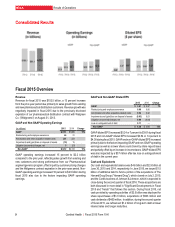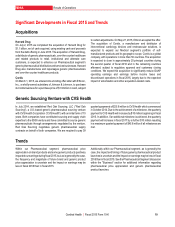Cardinal Health 2015 Annual Report Download - page 20
Download and view the complete annual report
Please find page 20 of the 2015 Cardinal Health annual report below. You can navigate through the pages in the report by either clicking on the pages listed below, or by using the keyword search tool below to find specific information within the annual report.
MD&A Critical Accounting Policies and Sensitive Accounting Estimates
19 Cardinal Health | Fiscal 2015 Form 10-K
Critical Accounting Policies and Sensitive Accounting Estimates
Critical accounting policies are those accounting policies that (i) can have a significant impact on our financial condition and results of operations
and (ii) require the use of complex and subjective estimates based upon past experience and management’s judgment. Other people applying
reasonable judgment to the same facts and circumstances could develop different estimates. Because estimates are inherently uncertain,
actual results may differ. In this section, we describe the significant policies applied in preparing our consolidated financial statements that
management believes are the most dependent on estimates and assumptions. For a discussion of additional accounting policies, see Note
1 of the “Notes to Consolidated Financial Statements.”
Allowance for Doubtful Accounts
Trade receivables are primarily comprised of amounts owed to us
through our distribution businesses and are presented net of an
allowance for doubtful accounts of $135 million and $137 million at
June 30, 2015 and 2014, respectively. We also provide financing to
various customers. Such financing arrangements range from 270
days to 5 years, at interest rates that are generally subject to
fluctuation. Interest income on these arrangements is recognized as
it is earned. The financings may be collateralized, guaranteed by third
parties or unsecured. Finance notes and related accrued interest are
reported net of an allowance for doubtful accounts of $14 million and
$18 million at June 30, 2015 and 2014, respectively, and are included
in other assets (current portion is included in prepaid expenses and
other) in the consolidated balance sheets. We must use judgment
when deciding whether to extend credit and when estimating the
required allowance for doubtful accounts.
The allowance for doubtful accounts includes general and specific
reserves. We determine the appropriate allowance by reviewing
accounts receivable aging, industry trends, customer financial
strength and credit standing, historical write-off trends and payment
history. We also regularly evaluate how changes in economic
conditions may affect credit risks.
Our methodology for estimating the allowance for doubtful accounts
is assessed annually based on historical losses and economic,
business and market trends. In addition, the allowance is reviewed
quarterly and updated if appropriate. We may adjust the allowance
for doubtful accounts if changes in customers’ financial condition or
general economic conditions make defaults more frequent or severe.
The following table gives information regarding the allowance for
doubtful accounts over the past three fiscal years:
(in millions, except percentages) 2015 2014 2013
Allowance for doubtful accounts $ 150 $ 156 $ 152
Reduction to allowance for customer
deductions and write-offs 70 51 34
Charged to costs and expenses 59 51 41
Allowance as a percentage of customer
receivables 2.2% 2.8% 2.3%
Allowance as a percentage of revenue 0.15% 0.17% 0.15%
A hypothetical 0.1 percent increase or decrease in the reserve as a
percentage of trade receivables and finance notes receivables at
June 30, 2015, would result in an increase or decrease in bad debt
expense of $7 million.
We believe the reserve maintained and expenses recorded in fiscal
June 30, 2015 are appropriate. At this time, we are not aware of any
analytical findings or customer issues that might lead to a significant
future increase in the allowance for doubtful accounts as a
percentage of revenue.
Inventories
A substantial portion of our inventories (58 percent and 61 percent at
June 30, 2015 and 2014, respectively) are valued at the lower of cost,
using the last-in, first-out ("LIFO") method, or market. These are
primarily merchandise inventories at the core pharmaceutical
distribution facilities within our Pharmaceutical segment. The LIFO
impact on the consolidated statements of earnings in a given year
depends on pharmaceutical price appreciation and the level of
inventory. Prices for branded pharmaceuticals generally tend to rise,
which results in an increase in cost of products sold, whereas prices
for generic pharmaceuticals generally tend to decline, which results
in a decrease in cost of products sold.
The LIFO method presumes that the most recent inventory purchases
are the first items sold, so LIFO helps us better match current costs
and revenue. Using LIFO, if there is a decrease in inventory levels
that have experienced pharmaceutical price appreciation, the result
generally will be a decrease in future cost of products sold as our
older inventory is held at a lower cost. Conversely, if there is a
decrease in inventory levels that have experienced a pharmaceutical
price decline, the result generally will be an increase in future cost
of products sold as our older inventory is held at a higher cost. We
believe that the average cost method of inventory valuation
reasonably approximates the current cost of replacing inventory
within the core pharmaceutical distribution facilities. Accordingly, the
LIFO reserve is the difference between (a) inventory at the lower of
LIFO cost or market and (b) inventory at replacement cost
determined using the average cost method of inventory valuation.
The remaining inventory is stated at the lower of cost, using the first-
in, first-out method, or market. If we had used the average cost
method of inventory valuation for all inventory within the
Pharmaceutical distribution facilities, the value of our inventories
would not have changed in fiscal 2015 or 2014. Inventories valued
at LIFO were $114 million and $98 million higher than the average
























